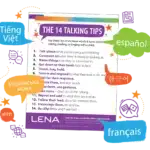 This has been a long year of staying inside and minimizing contact with friends and loved ones to help prevent the spread of coronavirus. As the seasons change and we head into a winter that will likely include even more “stay at home” guidance, we want to share some tips and strategies on how to make video calls fun, engaging, and as interactive as possible for infants and toddlers.
This has been a long year of staying inside and minimizing contact with friends and loved ones to help prevent the spread of coronavirus. As the seasons change and we head into a winter that will likely include even more “stay at home” guidance, we want to share some tips and strategies on how to make video calls fun, engaging, and as interactive as possible for infants and toddlers.
The American Academy of Pediatrics generally recommends that children under the age of two avoid using screens, but they make an exception for interactive video calls. As we well know, conversational turns can still occur virtually! Here are five mix-and-match ideas to boost the brain-building power of video calls by making them more interactive:
Try reading a book together.
During your next call, read a book with the child on the other end of the screen. If the child has the same book at their location, encourage them to follow along with the pictures, or you can hold the book up to the camera to show them the scenes. You could also try watching and discussing books together using a platform like Stories Online, or attending a virtual storytime hosted by your local library.
Use games, finger plays, songs, dances, rhymes and props.
We’re all experiencing a bit of Zoom fatigue this year, aren’t we? Children are no different, and adding some intrigue to your video calls can help to capture their attention and increase interaction. Try playing a game like peek-a-boo together or singing a song like “The Itsy Bitsy Spider” that includes finger plays. Consider bringing a puppet or stuffed animal to your call, and making up a story about what it has been doing during quarantine.
Incorporate the 14 Talking Tips – virtually!
Many of LENA’s 14 Talking Tips can be used to support virtual conversations, too! We recommend starting out with tip two, “Comment on what they’re doing or saying,” and tip nine, “Make faces, use gestures.” This one is especially fun with older children. Try making “big eyes” into the camera for 10 seconds, closing your eyes for 10 seconds, then holding your mouths wide open for 10 seconds and counting to 10 with your mouth open. It is impossible to do this without giggling!
Have an adult facilitate the call.
Video calls work best for infants and toddlers when adults are involved to explain what’s going on. If your child is Facetiming with Grandpa, for example, sit with them to facilitate the conversation and explain any technical glitches. This is a wonderful opportunity to model the 14 Talking Tips, too. When you use strategies like “wait for their response,” when engaging with your baby, other adults will notice and adopt the same patterns.
Open a dialogue with the people who care about your child, swapping strategies like these for making video calls interactive. You can even share a copy of the 14 Talking Tips or a video about why interaction matters. If you’re participating in a LENA program, try sharing a copy of your LENA report to spark a conversation about your child’s verbal interactions. (Note: You may see video calls categorized as “TV and electronic noise” on your report. During LENA Days, we recommend jotting down a quick note about when you made video calls with your child to reference when you’re looking back at your data later.)
Match the call length to their attention span.
Infants and toddlers might not be interested in video chatting for very long. That’s okay! If they want to move on to another activity, follow their interest and try the video call again on another day. You may find it’s helpful to schedule regular video calls with family members as part of your regular routine. For example, you could have Grandma skype with baby on certain days while you prepare dinner. This can eliminate the stress of scheduling or of a call that doesn’t go as planned.
Do you have another strategy that has worked well for your and your family? Comment below to share your ideas!



